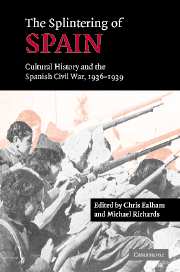Book contents
- Frontmatter
- Contents
- List of illustrations
- List of maps
- List of contributors
- Preface
- List of abbreviations
- Chronology
- Maps showing the division of Spain, 1936-1939
- 1 History, memory and the Spanish civil war: recent perspectives
- Part I Overviews: violence, nationalism and religion
- 2 The symbolism of violence during the Second Republic in Spain, 1931–1936
- 3 Nations in arms against the invader: on nationalist discourses during the Spanish civil war
- 4 ‘The keys of the kingdom’: religious violence in the Spanish civil war, July–August 1936
- Part II Republican political and cultural projects
- Part III Identities on the Francoist side
- Notes
- Index
4 - ‘The keys of the kingdom’: religious violence in the Spanish civil war, July–August 1936
Published online by Cambridge University Press: 28 July 2009
- Frontmatter
- Contents
- List of illustrations
- List of maps
- List of contributors
- Preface
- List of abbreviations
- Chronology
- Maps showing the division of Spain, 1936-1939
- 1 History, memory and the Spanish civil war: recent perspectives
- Part I Overviews: violence, nationalism and religion
- 2 The symbolism of violence during the Second Republic in Spain, 1931–1936
- 3 Nations in arms against the invader: on nationalist discourses during the Spanish civil war
- 4 ‘The keys of the kingdom’: religious violence in the Spanish civil war, July–August 1936
- Part II Republican political and cultural projects
- Part III Identities on the Francoist side
- Notes
- Index
Summary
The Child Jesus lay on one of the altar steps, a sky-blue ball spangled with silver stars…topped by a two-pronged stick… One of the prongs ended in the papier-mâché head of a fair-haired child with blue eyes, the other in a chubby pink hand…
[T]he miliciano shouted from the height of the altar. ‘Imagine all the money they got out of the silly, bigoted old women with the help of the little angel! But if one of them had lifted the petticoats and seen that broomstick underneath, she would have fainted, don't you think?’
Arturo Barea, The Clash (London: Fontana, 1984 [1944]), p. 168.The Spanish civil war was the occasion of the greatest anticlerical bloodletting Europe has ever seen. This extraordinary outpouring of violence claimed the lives of 4,184 priests and seminarians, among them twelve bishops, 2,365 monks and brothers and 283 religious sisters. In recent years the Catholic Church has beatified hundreds of the victims, 233 of them on 11 March 2001. This spectacular ceremony, the largest single number of beatifications in the church's history, emphasised the scale of the violence, which began immediately after the generals' coup d'état on 17–18 July 1936. In the remaining days of July, 861 priests and religious lost their lives, 95 of them on 25 July, feast day of St James, patron saint of Spain. August took the lives of a further 2,077 clerical victims, killed at an average of nearly seventy a day.
- Type
- Chapter
- Information
- The Splintering of SpainCultural History and the Spanish Civil War, 1936–1939, pp. 68 - 90Publisher: Cambridge University PressPrint publication year: 2005
- 6
- Cited by



